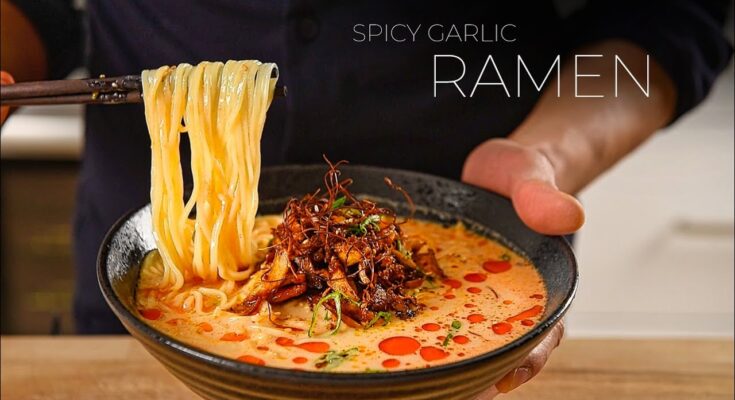Ramen Bowl Recipe: Ramen is more than just a comfort food—it’s a sensory experience. If you’ve only had instant noodles from a plastic packet, get ready to change your perspective. Homemade ramen bowls are rich, nourishing, and packed with umami goodness. They allow you to take full control over flavor, texture, and nutrition. You choose the ingredients, so there’s no mystery powder or overly salty broth. You get the real deal—slow-simmered broths, chewy noodles, and customizable toppings.
Making ramen at home also saves money. A single bowl at a good ramen shop can cost anywhere from $12 to $18. But for that same amount, you could make multiple servings at home and even have fun doing it. Whether you’re feeding a family, hosting friends, or just treating yourself to a cozy night in, a homemade ramen bowl is a smart, satisfying choice.
The Beauty of Customization
One of the biggest perks of homemade ramen is how easily it can be personalized. Prefer a light, clear broth over a creamy one? Go for shoyu (soy sauce-based). Need a vegan-friendly option? Miso or vegetable-based ramen has your back. Like it spicy? Toss in chili oil or gochujang. Craving protein? Add soft-boiled eggs, shredded chicken, tofu, or even marinated pork belly.
This flexibility also means you can cater to dietary restrictions. Gluten-free noodles, low-sodium broths, and veggie-loaded toppings all work beautifully. You don’t need to be a pro chef to create a bowl that tastes gourmet—you just need a bit of guidance, the right ingredients, and a willingness to experiment. And that’s exactly what this step-by-step guide is for.
Ingredients You’ll Need
Basic Ramen Broth Ingredients
The soul of any ramen bowl lies in the broth. It’s what gives the dish depth, richness, and that irresistible slurpable quality. Depending on the style you’re making, your broth will vary, but here are the staples for a classic version:
- Chicken or pork bones (or both) – for tonkotsu-style richness
- Garlic – smashed cloves add depth
- Ginger – fresh slices give warmth and brightness
- Onions – charred or caramelized for sweetness
- Soy sauce or miso paste – to layer umami
- Dried shiitake mushrooms – earthy and aromatic
- Kombu (dried sea kelp) – optional, but enhances savory notes
- Mirin or sake – for subtle sweetness and aroma
- Salt – essential for balancing flavors
Vegetarians can swap bones for miso, mushroom, and kombu-based broths, which deliver surprisingly rich results.
Essential Ramen Noodles
The noodles are just as important as the broth—they should be chewy, springy, and able to absorb flavor without getting soggy.
- Fresh ramen noodles – the best texture, usually found at Asian markets
- Dried ramen noodles – a decent substitute if fresh isn’t available
- Frozen ramen noodles – a great backup, often better than dried
- Gluten-free ramen noodles – rice or millet-based, available at health stores
Avoid instant noodles for this recipe. You want something with bite and texture—something that can stand up to the hearty broth and toppings.
Protein Options for Your Ramen Bowl
Protein adds substance and flavor to ramen bowls. Here are some classic and creative options:
- Soft-boiled eggs (marinated or plain)
- Chashu pork (braised pork belly or shoulder)
- Shredded rotisserie chicken
- Tofu (pan-fried or baked for texture)
- Ground beef or pork, cooked with garlic and miso
- Tempeh for a vegan alternative
Marinating eggs in soy sauce, mirin, and garlic overnight elevates them from ordinary to unforgettable.
Fresh and Flavorful Toppings
Toppings are where you get to play and make your bowl beautiful and personal. Here are popular options:
- Green onions (scallions) – thinly sliced
- Nori sheets – torn or cut into strips
- Corn kernels – sweet and buttery
- Bean sprouts – fresh and crunchy
- Bamboo shoots – adds texture and umami
- Pickled ginger – a zesty kick
- Sesame seeds – toasted for nutty aroma
- Spinach or bok choy – lightly blanched for color and nutrients
- Chili oil or paste – for those who love heat
Go wild with combinations or keep it minimal—either way, it’ll be delicious.
Optional Add-ons and Substitutions
Not everyone has access to traditional Asian ingredients, so here are some swaps and extras you can try:
- Soy sauce alternative: Tamari (gluten-free) or coconut aminos
- No mirin? Use a bit of sugar and rice vinegar
- Add richness: A small dollop of butter or a dash of sesame oil
- No kombu? Try a little miso paste or mushroom powder
- Craving crunch? Add fried onions or garlic chips
Don’t let a missing ingredient stop you. The beauty of ramen is that it adapts to your kitchen and your taste.
Kitchen Tools and Prep Work
Must-Have Tools for Making Ramen
Before diving into your ramen adventure, having the right tools on hand can make a world of difference. You don’t need a commercial kitchen, but a few key items will make your ramen bowl restaurant-worthy:
- Large stockpot – for simmering the broth slowly and thoroughly.
- Strainer or fine-mesh sieve – essential for removing bones and vegetable bits from the broth.
- Medium saucepan – perfect for boiling noodles separately.
- Sharp chef’s knife – for prepping your toppings and proteins.
- Cutting board – a sturdy one for all your slicing and dicing.
- Tongs or slotted spoon – for lifting out eggs or toppings with care.
- Soup ladle – to scoop the perfect amount of broth into each bowl.
- Ramen bowls – deep, wide bowls keep everything contained and steaming hot.
Optional but helpful extras include a bamboo skimmer for broth clarity, a ramen egg mold for perfect eggs, or even a torch if you want to char pork slices like a pro.
Prep Tips Before You Start Cooking
A successful ramen bowl starts with good prep. In the culinary world, this is known as mise en place—everything in its place. Having your ingredients chopped, measured, and ready to go ensures smooth cooking and prevents chaos in the kitchen.
Here’s how to prep efficiently:
- Read the full recipe first – Know what you’re about to do before you start doing it.
- Marinate your eggs in advance – at least 4–6 hours, preferably overnight.
- Soak your dried mushrooms and kombu – for deep umami flavor.
- Slice your veggies and proteins – uniform cuts help with even cooking.
- Boil water ahead of time for noodles – cook them just before serving.
- Have all seasonings and sauces lined up – no last-minute searching for the soy sauce.
This kind of thoughtful organization transforms cooking from a stressful chore into an enjoyable, creative process.
Step-by-Step Guide to Making Ramen Bowls
Step 1: Prepare the Broth (Meaty or Vegan)
The soul of ramen is the broth. For a meaty base, simmer chicken bones or pork bones with ginger, garlic, soy sauce, and green onions for at least 1–2 hours until rich and flavorful. For a vegan version, use vegetable broth and enhance it with miso paste, soy sauce, seaweed (kombu), mushrooms, and sesame oil. Strain the broth and keep it warm — this is where all the comfort lives.
Step 2: Cook the Noodles Perfectly
Boil fresh or dried ramen noodles according to the package instructions — usually 3–4 minutes. Don’t overcook; you want them springy, not soggy. Drain the noodles and toss them lightly in sesame oil to prevent sticking while you prep the rest.
Step 3: Prepare Your Toppings
Classic toppings elevate your ramen from simple to stunning. Popular options include soft-boiled eggs (ajitsuke tamago), sliced chashu pork, tofu cubes, corn, bamboo shoots, green onions, mushrooms, and nori (seaweed). You can also add bok choy or spinach for extra greens. Prep everything before assembling so your ramen doesn’t get cold waiting.
Step 4: Assemble Your Ramen Bowl
Place the noodles in a deep bowl first, then pour over the steaming hot broth. Arrange your toppings beautifully around the bowl — the egg halves should sit like royalty on top. Don’t stir right away; let the presentation shine before you dive in.
Step 5: Final Touches and Serving Tips
Add a few finishing touches — a drizzle of chili oil, toasted sesame seeds, or a spoonful of miso butter if you want to level it up. Serve immediately while hot and fragrant.
Enjoy your homemade ramen bowl — a perfect harmony of broth, noodles, and toppings that warms the soul and satisfies every craving.
Ramen Variations You’ll Love
Spicy Miso Ramen
Spicy miso ramen is for those who like a little kick with their comfort food. This rich, savory, and fiery bowl of ramen is packed with bold flavors and creamy textures that coat your taste buds with every slurp.
What makes it different?
- The broth is miso-based—using white or red miso paste blended into your ramen base.
- Chili oil, gochujang (Korean chili paste), or tobanjan (fermented chili bean paste) is added for spice.
- Often paired with ground pork or tofu sautéed in garlic, ginger, and chili oil.
- Toppings include corn, bok choy, green onions, ramen eggs, and sesame seeds.
This ramen variation is incredibly satisfying, especially in colder months. If you’re a fan of spicy food, this one’s a must-try. You can adjust the heat level by controlling how much chili oil or paste you add—so whether you’re a mild spice lover or a heat-chaser, it’s easy to customize.
Shoyu Ramen
Shoyu ramen is one of the oldest and most classic styles of ramen, and it remains popular for good reason. “Shoyu” means soy sauce, and this ramen’s broth is defined by its clear, brown, soy sauce-based soup.
Key components:
- Light and clear chicken or pork broth.
- Shoyu (soy sauce) adds depth, saltiness, and umami.
- Common toppings include bamboo shoots, scallions, ramen egg, nori, and sometimes narutomaki (fish cake).
- Often served with thin, curly noodles that absorb the shoyu broth perfectly.
Shoyu ramen offers a lighter, more balanced flavor profile compared to heavier miso or tonkotsu styles. It’s ideal for beginners or anyone looking for a traditional, comforting ramen experience without overwhelming richness.
Tonkotsu Ramen
Tonkotsu ramen is the heavyweight champion of the ramen world. This rich, creamy pork-bone broth is deeply satisfying and deeply flavorful—like a warm hug in a bowl.
What makes tonkotsu special:
- The broth is made by boiling pork bones, fat, and collagen for 12–18 hours.
- It results in a thick, milky-white soup that’s smooth and velvety.
- Noodles are typically thin and straight to contrast the richness of the broth.
- Toppings often include chashu pork, pickled ginger, green onions, black garlic oil, and a ramen egg.
This ramen is more labor-intensive, but the results are mind-blowing. It’s the type of dish you make when you want to impress or when you’re craving something truly indulgent. If you love richness, this is the holy grail.
Vegan Ramen Bowl
Who says ramen has to be all about pork and eggs? Vegan ramen has exploded in popularity because it proves you don’t need animal products to enjoy bold, satisfying flavors.
Vegan ramen essentials:
- Broth made from miso, kombu, mushrooms, and roasted vegetables.
- Toppings like crispy tofu, sautéed mushrooms, baby bok choy, corn, and bean sprouts.
- Noodles made without eggs—rice or wheat-based varieties are easy to find.
- Garnishes such as nori, chili oil, and sesame seeds to add the umami punch.
A well-made vegan ramen is just as comforting and flavorful as traditional versions. It’s perfect for plant-based eaters or anyone looking to lighten their meal without sacrificing taste.
Tips for Making the Best Ramen at Home
Balancing Flavors Like a Pro
The secret to a perfect bowl of ramen isn’t just ingredients—it’s balance. Too salty, and it overwhelms. Too bland, and it’s disappointing. Here’s how to get it just right:
- Salt, fat, acid, and umami must be in harmony. Soy sauce and miso bring salt and umami. Fat comes from the broth or toppings. Acid (like vinegar or citrus) brightens everything up.
- Taste as you go. Your broth should make you want to keep sipping.
- Layer flavor. Use roasted veggies, fermented ingredients, or double broth (chicken + mushroom) for depth.
- Avoid overseasoning. Start light—you can always add more miso, soy, or salt later.
Think of ramen like a song. Each ingredient is an instrument. Alone, they’re fine. Together? They make magic.
Avoiding Common Mistakes
Even with the best ingredients, small missteps can throw off your ramen game. Watch out for these pitfalls:
- Overcooking noodles: Makes them mushy. Always undercook slightly—they’ll finish cooking in hot broth.
- Cooking noodles in the broth: This releases starch, clouds the broth, and affects flavor.
- Skipping the straining step: Always strain your broth for clarity and texture.
- Neglecting toppings: Ramen isn’t just soup and noodles. Toppings add contrast, flavor, and texture.
- Not using enough salt: A bland broth is forgettable. Season gradually but confidently.
Remember: ramen is an art and a science. The more you practice, the better you’ll get—and the more fun it becomes.
Nutritional Information and Health Tips
Making Ramen Healthier
Ramen has a bad rep when it comes to health—but it doesn’t have to be a cheat meal. With the right swaps and smart portions, ramen can be wholesome, nourishing, and even packed with superfoods.
Here’s how to lighten it up:
- Use a veggie-based or clear chicken broth instead of heavy pork tonkotsu.
- Add greens like kale, spinach, or bok choy for fiber and vitamins.
- Swap pork belly for lean proteins like grilled chicken, tofu, or tempeh.
- Go easy on sodium—use low-sodium soy sauce or homemade broth where you control the salt.
- Watch the oil—drizzle sparingly with sesame or chili oil.
- Load up on veggies—carrots, mushrooms, sprouts, and seaweed bulk up the bowl without calories.
When built mindfully, ramen is a balanced dish with carbs, protein, healthy fats, and fiber.
Gluten-Free and Low-Sodium Swaps
For those with dietary restrictions, ramen can still be your friend:
Gluten-Free Options:
- Use gluten-free ramen noodles (made from rice, millet, or quinoa).
- Replace soy sauce with tamari or coconut aminos.
- Double-check miso paste for hidden wheat ingredients.
Low-Sodium Adjustments:
- Make your own broth to control salt levels.
- Use reduced-sodium soy sauce or skip it altogether and season with herbs, garlic, and miso.
- Skip salty toppings like pickled bamboo or cured meats.
Ramen is highly customizable, which means you can build it to match almost any dietary need without losing the fun or flavor.
Storage and Reheating Instructions
How to Store Leftovers Properly
Homemade ramen is best enjoyed fresh, but if you’ve made a big batch or want to meal prep, smart storage is key to keeping everything delicious. The most important rule? Store components separately.
Here’s how to do it:
- Broth: Let it cool completely, then transfer it into airtight containers. Store in the fridge for up to 5 days or freeze for up to 3 months.
- Noodles: Toss with a little oil to prevent sticking, then store in a sealed container for up to 3 days. Do not store them in the broth—they’ll turn mushy.
- Toppings: Store proteins, vegetables, and garnishes in separate containers if possible. Keep delicate toppings like scallions and nori wrapped in paper towels inside airtight containers to maintain freshness.
Label your containers with the date to keep track of freshness. If you’re prepping for the week, portion ingredients for each bowl in advance—this makes for quick and easy assembly later.
Best Ways to Reheat Ramen
When it’s time to enjoy your leftover ramen, reheating properly ensures it tastes just as good as day one.
Here’s how:
- Reheat the broth on the stove over medium heat until it’s piping hot.
- Warm noodles separately by dipping them briefly in boiling water or microwaving with a splash of water for 30–60 seconds.
- Reheat proteins gently. Avoid overcooking. Microwave on low or warm in a skillet with a splash of broth.
- Reassemble like a fresh bowl: place noodles in the bowl, add toppings, pour over hot broth, garnish.
Avoid microwaving the whole assembled ramen bowl—it leads to uneven heating and soggy noodles. Taking the extra few minutes to reheat each component separately makes a huge difference.
FAQs about Ramen Bowl Recipe
Can I make ramen without broth?
Technically, yes—you can make mazemen, a brothless ramen dish that relies on flavorful sauces and toppings. But for traditional ramen, broth is essential. It brings warmth, umami, and depth to the dish.
What noodles are best for homemade ramen?
Fresh ramen noodles from an Asian market are ideal. They have the best chew and hold up well in hot broth. If unavailable, dried or frozen noodles are solid substitutes. Avoid instant noodles for a more authentic experience.
How long does it take to make a ramen bowl?
If you’re making broth from scratch, expect 4 to 8 hours for deep flavor (especially for tonkotsu). But you can speed things up with a quicker miso or shoyu broth in 1 to 2 hours, or even use a store-bought base and focus on fresh toppings for a 30-minute meal.
Can I freeze homemade ramen?
Yes, but freeze components separately:
- Broth: Freeze in airtight containers.
- Noodles: Best made fresh, but you can freeze cooked noodles with a light coating of oil.
- Proteins: Freeze meats or tofu after cooking.
Never freeze a fully assembled bowl—it’ll turn soggy.
What’s the best protein for ramen?
It depends on the style. For rich bowls like tonkotsu, chashu pork is king. For lighter broths, go with chicken or tofu. For plant-based versions, crispy tofu or tempeh works great. You can even try ground meat, soft-boiled eggs, or seafood like shrimp.
Conclusion
There you have it—the ultimate, step-by-step guide to crafting your own ramen bowl at home. Whether you’re a seasoned cook or a curious beginner, making ramen from scratch is one of the most satisfying culinary experiences out there. From simmering the broth to perfectly cooking the noodles and artfully arranging the toppings, each step is a labor of love that pays off in every slurp.
Ramen isn’t just a meal—it’s an art form. It’s a blend of flavor, texture, and comfort that satisfies your stomach and your soul. And the best part? There’s no one “right” way to make it. Your kitchen, your rules.
So the next time you’re craving something warm, rich, and packed with flavor, skip the takeout. Grab your stockpot, gather your ingredients, and dive into the world of homemade ramen. You won’t just make dinner—you’ll make memories.



